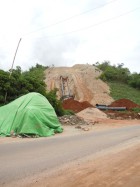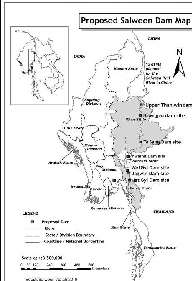English version below
Ces dernières décennies se sont multipliés les projets concernant l’exploitation de ressources naturelles, des contrats signés dans le secret mettant la population locale dans l’impossibilité de s’organiser.
Les routes sont refaites, employant le plus souvant des jeunes avec des salaires insuffisants.
De très nombreux barrages sont en cours de construction. Ils occasionnent des expropriations massives encadrées par l’armée et les relocalisations impliquent la modification des modes de vie. Ils visent la production d’énergie vendue aux pays limitrophes, alors que 79 % des Birmans en manquent.
Négociés sans concertation avec les populations locales, ils sont mal perçus. Ils occasionnent l’arrivée de chercheurs d’or et d’exploitants forestiers qui dégradent gravement l’environnement.
Les projets sont parfois situés sur une zone de séisme qui augmente le risque d’accident (à la frontière de l’État Shan, séisme le 20 août 2008). L’électricité est vendue à la Chine et la Thaïlande et les rentrées de devises ne servent pas au financement de projets profitant à la population.
– La submersion des zones menacent les espèces endémiques.
– La modification du débit affecte la qualité de l’eau et perturbe la navigation.
– L’eau stagnante entraîne la prolifération .de moustiques.
– Les travailleurs du chantier sont rarement recrutés sur place.
Dans l’État Kachin :
Le gouvernement birman a signé en mai 2007 avec China Power Investment Corporation un accord pour la construction de 7 barrages sur l’Irrawaddy, la Malika, et la N’Mai. Le barrage de Myitsone est le plus important (le plus gros de l’Asie du Sud-est, haut de, 152 mètres, pour une production annuelle de 29 400 KWh). Son réservoir sera plus grand que Singapour.
Le coût du barrage est estimé à US$ 3,6 milliards, et les revenus générés estimés à US $ 560 millions par an pour une électricité vendue à la Chine. L’impact particulier au projet : Le projet aggrave les risques de conflit pour du travail et le trafic humain avec la Chine. 60 villages, soit 20 000 personnes doivent être relocalisées. Il a été suspendu jusqu’à fin 2015 par le Président Thein Sein suite à la mobilisation de la population.Les sociétés impliquées sont birmanes ou Chinoises.
D’autres barrages, en amont de Myitsone sont nombreux : Barrage de Chibwe – capacité : 3,400 MW, Barrage de Chibwe Nge – capacité : 99 MW, Barrage de Pashe – capacité : 1,600 MW, Barrage de Lakin – capacité : 1,400 MW, Barrage de Phizaw – capacité : 1,500 MW, Barrage de Khaunglanphu – capacité : 1,700 MW, Barrage de Laiza – capacité : 1,560 MW
2 barrages sur la rivière Dapein sont construits par la Chine qui bénéficie de 90 % de l’électricité produite. Des conflits ont éclaté entre l’armée et la KIA en juin 2011 menant au déplacement de 30 000 personnes. En parallèle du projet de barrage, les autorités ont accordé une licence pour l’exploitation de l’or à deux sociétés, Thandar Shwe Zin et For Luck. Le cours du fleuve s’est élargi de 200 mètres et provoqué des inondations. 300 bateaux se sont installés ; de fortes concentrations de mercure et cyanure ont été relevées avec les conséquences sur la santé des habitants.
Sur la Salween sont aussi prévus de nombreux barrages :
Hat Gyi a été construit, près de la réserve Kahilu Wildlife Sanctuary suite à un accord signé en 2006 entre le gouvernement Birman, Electricity Generating Authority of Thailand (EGAT), et la société chinoise Sinohydro. En 1999, l’étude réalisée recommandait une capacité de 300 Mégawatts mais en 2005, une étude du Ministère de l’Énergie Thaï a proposé 4 fois plus.
Caractéristiques du barrage : hauteur : 33 mètres, production annuelle : 7 335 Gwh. Le coût du projet est estimé à US $1 milliard et l’électricité produite sera vendue à la Thaïlande. L’étude sur le barrage de Hatgyi a occasionné un violent conflit ; des dizaines de villages Karen ont été déplacés. Plusieurs offensives militaires ont eu lieu dans le but de sécuriser la zone.
Les autres barrages sur la Salween :Tasang (État Shan), plus grand que cle barrage des 3 gorges en Chine (hauteur 228 m, capacité: 7,110 MW, production annuelle : 35 446 GHW). Les sociétés impliquées sont Birmanes, Chinoises et Britannique (Malcolm Dunstan & Associates). Le coût du barrage est estimé à US $ 6 milliards. L’électricité sera majoritairement vendue à la Thaïlande. 300 000 personnes ont déjà été déplacées sur la zone de ce seul barrage depuis 1996.
Wei Gyi : le site se trouve tout près de la frontière Thaï, dans l’État Kayah (hauteur de 220 mètres, capacité de 4 540 mégawatt) ; la zone submergée couvre une superficie de 700 à 1 000 km2 de terres cultivables. Le coût du barrage est évalué à US$ 3 milliards.
Upper Thanlwin (Nord de l’État Shan) : un accord a été signé en 2007, entre le gouvernement Birman et 2 sociétés Chinoises puis un nouvel accord a été signé en 2010 pour la construction de 3 barrages supplémentaires à Ywathit, et sur les rivières Pawn et Thabet. Le coût du projet est évalué à US $ 600 millions. En février 2011, l’armée sécurisait la zone du projet, interdite d’accès à la population. L’électricité partira en Thaïlande.
Dagwin : la capacité estimée du barrage est de 500 à 900 MW; le barrage produira de l’électricité mais il est surtout destiné à réguler l’eau lâchée par le barrage de Wei Gyi aux heures de pointe (hauteur : 56 mètres, capacité prévue : 792 MW). Les sociétés impliquées sont : Electricity Generating Authority of Thailand (EGAT).
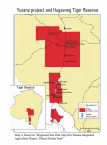 Un projet agricole dans l’État Kachin (vallée de Hukawng). Projet de monoculture de manioc, canne à sucre, et jatropha (bio fuel) sur 809 km2 sur des terrains accordés en 2006 par Than Shwe à Yuzana Company, au coeur de la « Réserve de tigres » de la vallée de Hukawng ; en rouge sur la carte apparaissent les zones accordées. Entre les blocs se trouvent des villages convoités par Yuzana. En 2007, les expropriations démarrent et les villageois se mobilisent et écrivent à Than Shwe. Traditionnellement, ils cultivent riz, haricots, pois, thé, moutarde, maïs, oranges, ananas, bananes, ramboutans. Les autorités locales invoquent une réglementation dont le non-respect mène à la saisie des terres. Des affrontements. Birdlife International signale les premières disparitions d’espèces en 2008.En 2009, Yuzana démarre la construction de l’usine sécurisée par l’armée et fait suivre au personnel un entraînement militaire. En 2010, les villageois de Ban Kawk sont attaqués et demandent l’intervention de l’OIT ; ils se voient refuser leurs cartes d’identité et l’enregistrement des maisons, ce qui en fait des résidents temporaires dans le pays. En juin, le village d’Aung Ra est rasé. La société Yuzana a construit un village modèle à Sanbya Kwye Ywa pour regrouper les villageois expulsés. En 2010, 163 foyers avaient déménagé dans des abris temporaires ; les autorités leur ont demandé de signer un papier attestant qu’ils partaient de leur plein gré.
Un projet agricole dans l’État Kachin (vallée de Hukawng). Projet de monoculture de manioc, canne à sucre, et jatropha (bio fuel) sur 809 km2 sur des terrains accordés en 2006 par Than Shwe à Yuzana Company, au coeur de la « Réserve de tigres » de la vallée de Hukawng ; en rouge sur la carte apparaissent les zones accordées. Entre les blocs se trouvent des villages convoités par Yuzana. En 2007, les expropriations démarrent et les villageois se mobilisent et écrivent à Than Shwe. Traditionnellement, ils cultivent riz, haricots, pois, thé, moutarde, maïs, oranges, ananas, bananes, ramboutans. Les autorités locales invoquent une réglementation dont le non-respect mène à la saisie des terres. Des affrontements. Birdlife International signale les premières disparitions d’espèces en 2008.En 2009, Yuzana démarre la construction de l’usine sécurisée par l’armée et fait suivre au personnel un entraînement militaire. En 2010, les villageois de Ban Kawk sont attaqués et demandent l’intervention de l’OIT ; ils se voient refuser leurs cartes d’identité et l’enregistrement des maisons, ce qui en fait des résidents temporaires dans le pays. En juin, le village d’Aung Ra est rasé. La société Yuzana a construit un village modèle à Sanbya Kwye Ywa pour regrouper les villageois expulsés. En 2010, 163 foyers avaient déménagé dans des abris temporaires ; les autorités leur ont demandé de signer un papier attestant qu’ils partaient de leur plein gré.
Le projet Shwe, signé en 2007 par Than Shwe avec la Chine, concerne l’accord pour la vente et l’approvisionnement de 180 milliards m3 de gaz sur 30 ans provenant de la Mer d’Andaman soit 100 % de la production. Le pipeline et le gazoduc construits éviteront que les importations chinoises en provenance du Moyen-Orient ne passent par le détroit de Malacca reliant le port de Sittwe à Kunming (Yunnan). Les travaux ont commencé en 2009. A ces projets s’ajoutent la construction de réservoirs de stockage à Kyaukpyu par la China National Petroleum Corp. (CNPC). On estime que ce projet apportera au gouvernement birman environ US $ 56 milliards sur 30 ans. L’environnement de toute la région est affecté négativement par ce projet. Le pipe, terminé en 2013, fournit à la Chine, unique client, 10 % de ses importations de pétrole. La Chine construit également un chemin de fer pour un coût de US $ 20 milliards. Pour sécuriser la zone, de nombreux bataillons de l’armée sont arrivés sur l’île de Kyaw Pyu ; pratiquement personne n’a été embauché. Moins de 2/3 des personnes déplacées ont reçu des compensations, en partie récupérées par le gouvernement local.
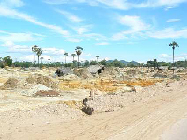 Le projet minier de Monywa Le projet minier de Leptadaung a démarré en 1999, concerne l’extraction du cuivre à ciel ouvert (27 000 tonnes de cuivre / an), par une joint-venture entre le gouvernement Birman et Canada Ivanhoe Mines Limited, vendu à Marubeni Corporation (Marubeni Corporation est la 5e plus grosse société japonaise qui a financé un prêt d’US $ 90 millions pour l’équipement du projet.), société Japonaise qui a financé le projet à heuteur de US $ 90 millions. Les process utilisés sont très polluants. Au projet s’ajoute l’extraction par des individuels. Le projet doit pourtant être étendu avec la société Daewoo (Corée du sud). Les procédés techniques et chimiques utilisés faisant intervenir un solvant organique contenant de l’acide sulfurique sont très destructeurs pour l’environnement.(Source :http://www.kdng.org).
Le projet minier de Monywa Le projet minier de Leptadaung a démarré en 1999, concerne l’extraction du cuivre à ciel ouvert (27 000 tonnes de cuivre / an), par une joint-venture entre le gouvernement Birman et Canada Ivanhoe Mines Limited, vendu à Marubeni Corporation (Marubeni Corporation est la 5e plus grosse société japonaise qui a financé un prêt d’US $ 90 millions pour l’équipement du projet.), société Japonaise qui a financé le projet à heuteur de US $ 90 millions. Les process utilisés sont très polluants. Au projet s’ajoute l’extraction par des individuels. Le projet doit pourtant être étendu avec la société Daewoo (Corée du sud). Les procédés techniques et chimiques utilisés faisant intervenir un solvant organique contenant de l’acide sulfurique sont très destructeurs pour l’environnement.(Source :http://www.kdng.org).
Au projet de Myanmar Ivanhoe Copper Company Limited s’ajoute l’extraction par des mineurs individuels qui creusent pour extraire moins de 2 kg de cuivre pour 1000 kg de sol remué avec des dommages irrémédiables. La loi encadre l’extraction minière par l’intermédiaire de la National Commission for Environmental Affairs (NCEA) créée en 1990, et la National Environmental Policy (NEP). Dans la réalité, la loi sur l’extraction minière de 1994 protège les sociétés minières et non pas la population. Ce sont des société Chinoises qui ont repris l’exploitation et les conditions d’exploitation ont poussé la population à s’organiser et alerter les pouvoirs publics. Selon The Irrawaddy, 400 personnes ont manifesté demandant aux autorités une enquête sur les événements du 29 novembre 2012 au cours desquels 70 personnes ont été blessées. Ils reprochent à les sociétés Chinese company Wanbao et la société birmane Union of Myanmar Economics Holdings appartenant à l’armée, de ne pas suivre les recommandations émises par le rapport de la commission d’enquête. 26 villages ont été déplacés et plus de 7 000 acres de terrains confisquées.( http://www.irrawaddy.org/archives/37140).
La commission d’enquête, dirigée par Aung San Suu Kyi a reconnu que des bombes au phosphore avaient été utilisées contre les manifestants, mais elle a également plaidé pour la continuation du projet alors que de nombreux riverains veulent son arrêt pour récupérer leurs terres saisies. Aung San Suu Kyi a demandé aux paysans d’accepter les compensations proposées. Les terres sont cédées à la mine pour 60 ans. A la suite de ce rapport, le contrat d’exploitation a été revu et octroie au gouvernement birman 51% des revenus. Le groupe chinois Wanbao recevra 30% des revenus de la mine et l’entreprise appartenant à l’armée birmane Myanmar Economic Holding(MEH) 19%. Wanbao devra également débourser plusieurs millions de dollars pour des actions de responsabilité sociale des entreprises et d’éventuelles réclamations.
Le projet de Dawei
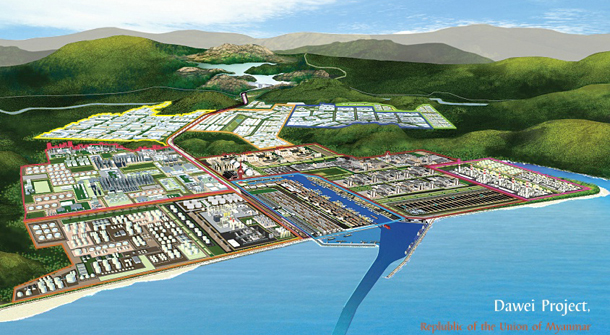 Construction d’un port en eaux profondes et d’une zone spéciale économique. a été approuvé en mars 2010, et concerne la construction du plus gros complexe industriel d’Asie du Sud-est ; il intègre un port en eaux profondes 6 fois plus important que celui de Rayong en Thaïlande (contrat attribué à Max Myanmar Group of Companies), des autoroutes, une voie ferrée, un oléoduc et un gazoduc, une centrale à charbon et une zone industrielle (Special Economic zone, SEZ) de 250 km2 (et situé dans une zone de conflit. Les bulldozers ont démarré les travaux de la route qui mènera au déplacement de 10 000 personnes. Les activistes réclament justice autour du projet (US$ 6 milliards). L’investisseur majoritaire Max Myanmar s’est retiré du projet mais 3 accords ont été signés avec la Thaïlande, remettant le projet sur les rails, causant le déplacement de 30 000 personnes. Le dessin montre le centre industriel pétrochimique. De nombreuses sociétés étrangères travaillent sur le projet, bénéficiant de coûts de main d’œuvre très bas et de peu de contraintes concernant l’environnement. Ils ont reçu le terrain du gouvernement pour 60 ans pour un projet qui touche 21 villages, soit 32 274 personnes. Au début du projet, aucune information n’a été donnée à la population et, lorsque les expulsions ont commencé, les villageois ont refusé les compensations poussant ITD à transférer le problème des compensations au gouvernement Birman, ce que refusait aussi la population à cause de la corruption. Le projet doit être complété par une route qui rejoindra Bangkok, investissement évalué à US $ 10 millions dont 54 % seront financés par ITD, permettant d’éviter le détroit de Malacca pour les marchandises venant du Moyen Orient, notamment le pétrole. Un projet similaire moins important en Thaïlande a dû être abandonné en raison des protestations. Les sociétés Birmanes impliquées sont Max Myanmar et Dawei Development Company (joint-venture entre ITD et MM). 19 villages devront être relocalisés, dont 23 édifices culturels et religieux, 21 écoles. Les sociétés, Birmanes, aggravent le ressenti contre le gouvernement.
Construction d’un port en eaux profondes et d’une zone spéciale économique. a été approuvé en mars 2010, et concerne la construction du plus gros complexe industriel d’Asie du Sud-est ; il intègre un port en eaux profondes 6 fois plus important que celui de Rayong en Thaïlande (contrat attribué à Max Myanmar Group of Companies), des autoroutes, une voie ferrée, un oléoduc et un gazoduc, une centrale à charbon et une zone industrielle (Special Economic zone, SEZ) de 250 km2 (et situé dans une zone de conflit. Les bulldozers ont démarré les travaux de la route qui mènera au déplacement de 10 000 personnes. Les activistes réclament justice autour du projet (US$ 6 milliards). L’investisseur majoritaire Max Myanmar s’est retiré du projet mais 3 accords ont été signés avec la Thaïlande, remettant le projet sur les rails, causant le déplacement de 30 000 personnes. Le dessin montre le centre industriel pétrochimique. De nombreuses sociétés étrangères travaillent sur le projet, bénéficiant de coûts de main d’œuvre très bas et de peu de contraintes concernant l’environnement. Ils ont reçu le terrain du gouvernement pour 60 ans pour un projet qui touche 21 villages, soit 32 274 personnes. Au début du projet, aucune information n’a été donnée à la population et, lorsque les expulsions ont commencé, les villageois ont refusé les compensations poussant ITD à transférer le problème des compensations au gouvernement Birman, ce que refusait aussi la population à cause de la corruption. Le projet doit être complété par une route qui rejoindra Bangkok, investissement évalué à US $ 10 millions dont 54 % seront financés par ITD, permettant d’éviter le détroit de Malacca pour les marchandises venant du Moyen Orient, notamment le pétrole. Un projet similaire moins important en Thaïlande a dû être abandonné en raison des protestations. Les sociétés Birmanes impliquées sont Max Myanmar et Dawei Development Company (joint-venture entre ITD et MM). 19 villages devront être relocalisés, dont 23 édifices culturels et religieux, 21 écoles. Les sociétés, Birmanes, aggravent le ressenti contre le gouvernement.
In recent decades there has been a proliferation of projects involving the exploitation of natural resources. Common points emerge from these projects: contracts signed in secret making the local population impossible to organize themselves.
Roads are built, employing young boys or girls with unsufficient salaries.
Many dams are under construction. The projects cause massive expropriations controlled by the army. They target the production of energy sold to neighbouring countries, while 79% of Burmese lack it.
Negotiated without consultation with local populations, the projects are poorly perceived. They are sometimes located in an earthquake zone that increases the risk of an accident (on the border of Shan State, earthquake on August 20, 2008). Electricity is sold to China and Thailand and foreign exchange receipts are not used to finance projects that benefit the population.
– Flooding threatens endemic species
– Changes in flow affect water quality and disrupt navigation.
– Stagnant water causes mosquitoes to grow.
– Site workers are rarely recruited on site.
Other dams upstream of Myitsone include Chibwe Dam – capacity: 3,400 MW, Chibwe Nge Dam – capacity: 99 MW, Pashe Dam – capacity: 1,600 MW, Lakin Dam – capacity: 1,400 MW, Phizaw Dam – capacity: 1,500 MW, Khaunglanphu Dam – capacity: 1,700 MW, Laiza Dam – capacity: 1,560 MW2 dams on the Dapein River are built by China which benefits from 90% of the electricity produced. Conflicts broke out between the army and the KIA (Kachin Independance Army) in June 2011, resulting in the displacement of 30,000 people.
In parallel to the dam project, the authorities granted a gold license to two companies, Thandar Shwe Zin and For Luck. The course of the river widened by 200 meters and caused flooding. 300 boats have set up; high concentrations of mercury and cyanide have been noted with the consequences on the health of the inhabitants.
On Upper Thanlwin (Northern Shan State): an agreement was signed in 2007, between the Burmese government and 2 Chinese companies then a new agreement was signed in 2010 for the construction of 3 additional dams in Ywathit, and on the Pawn and Thabet rivers. The cost of the project is estimated at US$600 million. In February 2011, the army secured the project area, which was closed to the population. The electricity will go to Thailand.
Dagwin: the estimated capacity of the dam is 500 to 900 MW; the dam will produce electricity but it is mainly intended to regulate the water released by the Wei Gyi dam during peak hours (height: 56 meters, expected capacity: 792 MW). The companies involved are: Electricity Generating Authority of Thailand (EGAT).
The Construction project for a deep-water port and an economic special area. was approved in March 2010, and concerns the construction of the largest industrial complex in Southeast Asia; it incorporates a deep water port 6 times larger than that of Rayong in Thailand (contract awarded to Max Myanmar Group of Companies), highways, a rail line, an oil and gas pipeline, a coal-fired power plant and a 250 km2 Special Economic Zone (SEZ) (and located in a conflict zone. The bulldozers have begun work on the road that will move 10,000 people. Activists demand justice around the project (US$ 6 billion). Majority investor Max Myanmar withdrew from the project but 3 agreements were signed with Thailand, putting the project back on track, causing the displacement of 30,000 people. Many foreign companies are working on the project, benefiting from very low labour costs and low environmental constraints. They received the government land for 60 years for a project that affects 21 villages, or 32,274 people. At the beginning of the project, no information was given to the population and, when the evictions began, the villagers refused compensation urging ITD to transfer the compensation problem to the Burmese government, which the population also refused because of corruption. The project is to be completed by a road that will reach Bangkok, an investment valued at US$ 10 million, 54% of which will be financed by ITD, making it possible to avoid the Strait of Malacca for goods coming from the Middle East, including oil. A similar smaller project in Thailand had to be abandoned due to protests. The Burmese companies involved are Max Myanmar and Dawei Development Company (joint venture between ITD and MM). 19 villages will have to be relocated.
